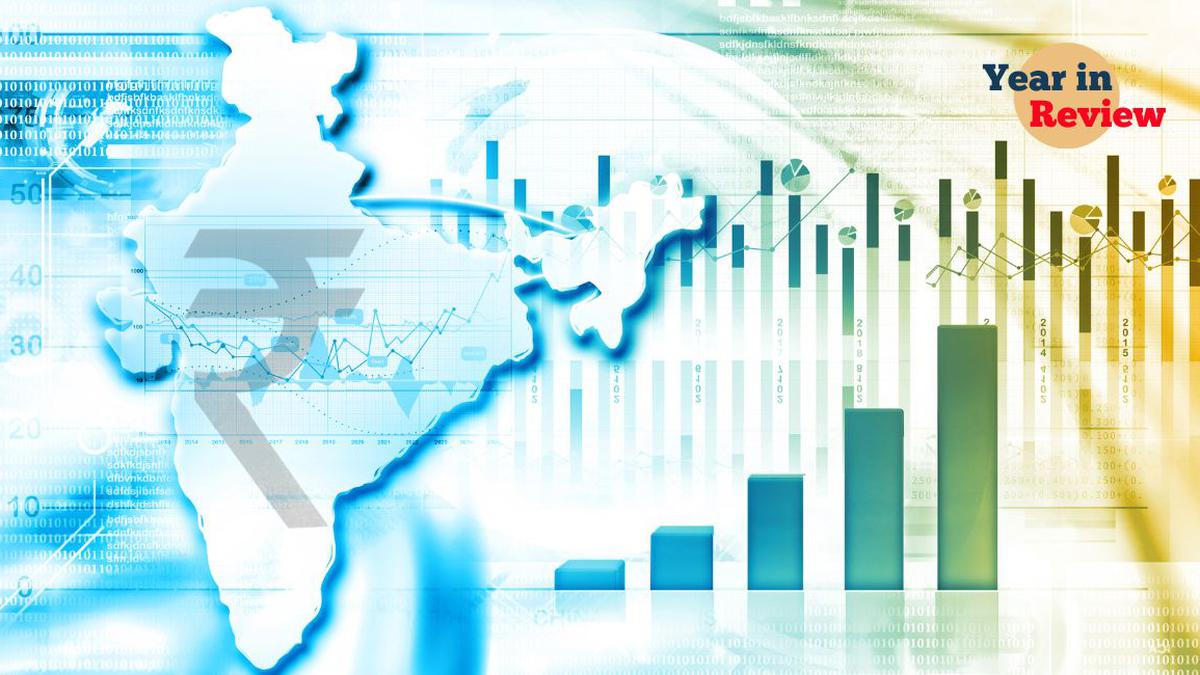
Multiple headwinds at diversified factors of time impacted the Indian financial system’s thorough financial revival within the calendar yr 2022. The yr began with the risk emanating from the Omicron variant which settled in the direction of the later finish of the succeeding month. This was adopted by the Russian actions in Ukraine and the following disturbances in world provide chains and inflation. With superior economies tightening their financial coverage stance, it affixed ripple impact in world markets and to the economies of rising and low-income international locations.
The Indian financial system too was not aloof to the headwinds with the central regulator, the Reserve Bank of India (RBI), always alternating between deal with progress after easing of the Omicron-induced wave and combatting inflation by tightening their financial coverage stance.
Here are how the broader financial indicators panned out in 2022 and the currents that formed them:
In the primary half of the continuing monetary yr, the Indian financial system registered a GDP progress of 9.7% in comparison with 13.7% on a year-over-year comparability. Gross Value Added (GVA) rose 9% in comparison with 12.8% throughout the identical interval final yr. GDP within the June-end quarter, although decrease than the RBI’s projection, rose 13.5% aided by an uptick in personal consumption spending and gross mounted capital formation with a moderation in authorities ultimate expenditure.
Also learn | IMF tasks 6.8% progress, says India navigating ‘very difficult’ exterior atmosphere
In the September-end quarter with the normalisation of the bottom impact, GDP progress slowed to six.3%. The mining and manufacturing sectors skilled contraction, mixed with excessive inflation, weak exports and elevated enter costs in sure sectors led GVA rising slower-than-expected at 5.6%. “India’s growth rates in real terms of 9.7% in the first half of this year is well above the trend in other countries and is happening amid tightening global financial conditions and the commodity price shock since the Ukraine invasion by Russia,” CEA V. Anantha Nageswaran had emphasised.
Also learn | Global slowdown not mirrored in India, says Finance Ministry
Consumer Price Index (CPI) inflation, or retail inflation, was above the central regulator’s 6%-upper tolerability threshold for ten consecutive months earlier than easing to five.88% in November. It reached an eight-year excessive of seven.79% in April with rural inflation scaling to eight.4% and concrete inflation at 7.1%. Analysts attributed the rise to the sharp spike in meals inflation – which rose to a 17-month excessive of 8.4% from 7.7% on a sequential foundation. They defined the continued world surge in crude costs impacted meals, gasoline, and lightweight, in addition to transport and communication.
In truth, adhering to the medium-term inflation focusing on framework, the RBI carried out an extra assembly of the MPC in November this yr to jot down a letter explaining the explanations for lacking its inflation targets and chart particulars on when it could obtain the goal of 4%. The ease in November was largely because of the correction in costs of meals gadgets. However, this was accompanied with the Index for Industrial Production (IIP), a composite indicator that signifies the short-term adjustments within the quantity of manufacturing for a basket of commercial merchandise throughout a given interval compared to a base interval, additionally contracting 4%. Retail inflation figures for the month of December could be printed on January 12, 2023.
Standard & Poor’s Manufacturing Purchasing Managers’ Index (PMI) is a weighted common of indices constituting new orders, output, employment, suppliers’ supply instances, and shares of purchases. It signifies the general well being of the financial system and its key financial drivers as exports, capability utilisation, employment and inventories, amongst different issues.
With respect to India, the index recorded its finest in July and August at 56.4 and 56.2 respectively. Pollyanna De Lima, Economics Associate Director at S&P Global Market Intelligence had then noticed that Indian producers continued to profit from the absence of COVID-19 restrictions. Rate of progress for each output and new orders had been selecting up but once more to the strongest since November 2021.
In November this yr, it recorded its strongest upturn in output since August at 55.7. The researchers concurred that however heightened recession fears elsewhere and a deteriorating outlook for the worldwide financial system, India’s manufacturing sector continued to carry out properly. They had been additionally aided by a considerable cooling of value pressures in November – prompting them to buy extra inputs and add to their inventories, the researchers said.
The Monetary Policy Committee (MPC) in April voted unanimously voted to maintain the repo charge unchanged at 4 per cent. It defined the choice was to “remain accommodative while focussing on withdrawal of accommodation to ensure that inflation remains with the target going forward, while supporting growth.” The Governor had said the graduation of the geopolitical tensions in Eastern Europe from February twenty fourth had induced “tectonic shift” within the world financial system. Extreme volatility characterised commodity and monetary markets.
Also learn |Economic progress ‘extremely fragile’, wants all help: MPC member Jayanth Varma
The committee met off-cycle in May in lieu of the prevailing world macroeconomic state of affairs. It voted unanimously to extend the coverage repo charge by 40 foundation factors to 4.40%. It defined that world inflation was “rising alarmingly and spreading fast”, including, “Geopolitical tensions are ratcheting up inflation to their highest levels in the last 3 to 4 decades in major economies while moderating external demand.”
In three subsequent cycles, RBI opted to lift the repo charges by 50 foundation factors on every occasion. It peaked to five.9% in September till in December, it moderated the speed of enhance to 35 foundation factors, thus, the repo charge presently stands at 6.25%.
Also learn |Is the financial system driving with the brakes on?
It had famous that that progress prospects globally had been dampening and monetary markets stay nervous and characterised by excessive volatility and value swings. As for the Indian financial system, it said, “The medium-term inflation outlook is exposed to heightened uncertainties from geopolitical tensions, financial market volatility and the rising incidence of weather-related disruptions.” Notwithstanding, it said the outlook was supported by sustained city demand, bettering rural demand, a pick-up in manufacturing, rebound in providers and sturdy credit score growth.
The MPC is subsequent slated to fulfill on February 6, 2023.
In December 2021, the Centre for Monitoring Indian Economy (CMIE) estimated that just about 53 million Indians had been unemployed, a big proportion being girls. The unemployment charge was hovering at 7.91% in December 2021, and although there was some dip in unemployment in early 2022, the determine now stands at a worrying 8% (as of November 2022). CMIE’s Managing Director Mahesh Vyas had famous that a lot of the jobs added in November had been in rural India and the rise within the unemployed was primarily in city India.
Further, individually he said, “India’s unemployment rate has not crossed 8 per cent too often during non-lockdown times. In the past 17 months, the unemployment rate has crossed 8 per cent on four occasions,” he said.
In August this yr, unemployment had surged to one-year excessive as erratic rainfall impacted sowing actions, thus, translating into decrease rural employment. Back then, the city unemployment charge had gone on to the touch 9.6% whereas rural unemployment touched 7.7%. In September, the unemployment charge had fallen drastically to six.43% backed by a rise in labour participation in rural and concrete areas. CMIE’s Managing Director Mahesh Vyas had advised news-agency PTI again then that the just about 8-million enhance in labour participation is an indication that India’s financial system was doing properly.
Also learn |The period of an unemployed India
The Indian rupee hit an all-time low towards the U.S. greenback this yr weakening previous the 82 rupees to a greenback mark. The worth of any forex is decided by the demand for the forex in addition to its provide. When the provision of a forex will increase, its worth drops. On the opposite hand, when the demand for a forex will increase, its worth rises. In the broader financial system, central banks decide the provision of currencies, whereas the demand for currencies will depend on the quantity of products and providers produced within the financial system. Since March this yr, the U.S. Federal Reserve has been elevating its benchmark rate of interest inflicting traders looking for increased returns to tug capital away from rising markets reminiscent of India and again into the U.S. This, in flip, has put strain on rising market currencies which have depreciated considerably towards the U.S. greenback.



